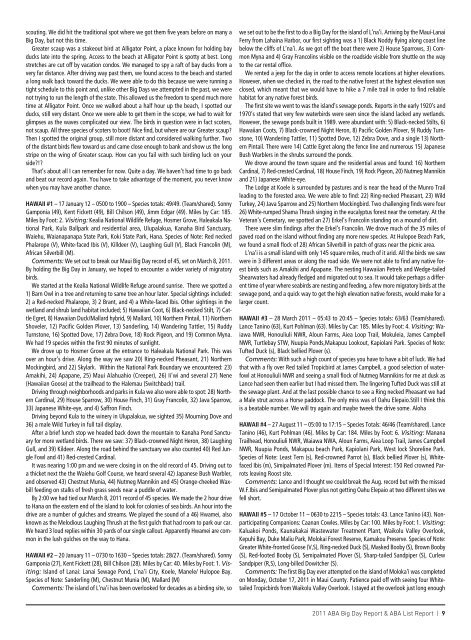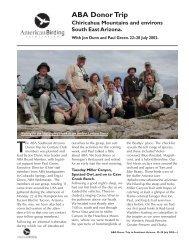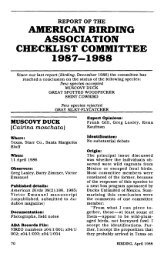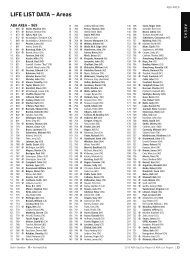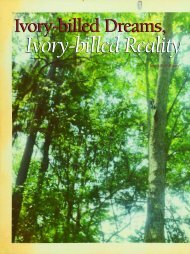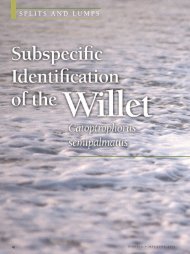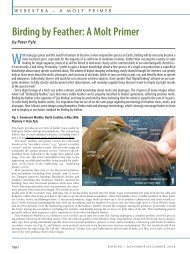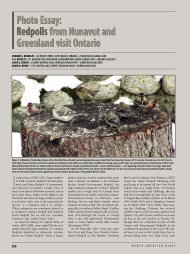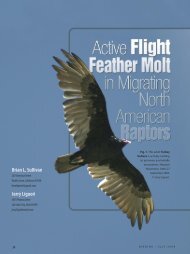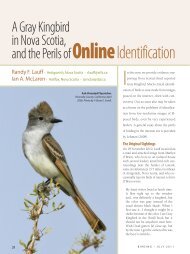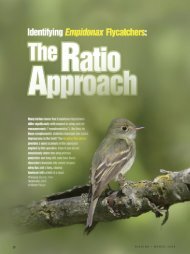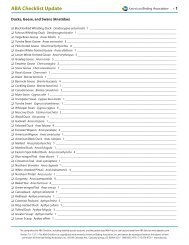2011 ABA Big Day & List Report - ABA Listing Central - American ...
2011 ABA Big Day & List Report - ABA Listing Central - American ...
2011 ABA Big Day & List Report - ABA Listing Central - American ...
- No tags were found...
You also want an ePaper? Increase the reach of your titles
YUMPU automatically turns print PDFs into web optimized ePapers that Google loves.
scouting. We did hit the traditional spot where we got them five years before on many a<strong>Big</strong> <strong>Day</strong>, but not this time.Greater scaup was a stakeout bird at Alligator Point, a place known for holding bayducks late into the spring. Access to the beach at Alligator Point is spotty at best. Longstretches are cut off by vacation condos. We managed to spy a raft of bay ducks from avery far distance. After driving way past them, we found access to the beach and starteda long walk back toward the ducks. We were able to do this because we were running atight schedule to this point and, unlike other <strong>Big</strong> <strong>Day</strong>s we attempted in the past, we werenot trying to run the length of the state. This allowed us the freedom to spend much moretime at Alligator Point. Once we walked about a half hour up the beach, I spotted ourducks, still very distant. Once we were able to get them in the scope, we had to wait forglimpses as the waves complicated our view. The birds in question were in fact scoters,not scaup. All three species of scoters to boot! Nice find, but where are our Greater scaup?Then I spotted the original group, still more distant and considered walking further. Twoof the distant birds flew toward us and came close enough to bank and show us the longstripe on the wing of Greater scaup. How can you fail with such birding luck on yourside?!?That’s about all I can remember for now. Quite a day. We haven’t had time to go backand beat our record again. You have to take advantage of the moment, you never knowwhen you may have another chance.HAWAII #1 – 17 January 12 – 0500 to 1900 – Species totals: 49/49. (Team/shared). SonnyGamponia (49), Kent Fickett (49), Bill Chilson (49), Jimm Edgar (49). Miles by Car: 185.Miles by Foot: 2. Visiting: Kealia National Wildlife Refuge, Hosmer Grove, Haleakala NationalPark, Kula Ballpark and residential area, Ulupalakua, Kanaha Bird Sanctuary,Waiehu, Waianapanapa State Park, Koki State Park, Hana. Species of Note: Red neckedPhalarope (V), White-faced Ibis (V), Killdeer (V), Laughing Gull (V), Black Francolin (M),African Silverbill (M).Comments: We set out to break our Maui <strong>Big</strong> <strong>Day</strong> record of 45, set on March 8, <strong>2011</strong>.By holding the <strong>Big</strong> <strong>Day</strong> in January, we hoped to encounter a wider variety of migratorybirds.We started at the Kealia National Wildlife Refuge around sunrise. There we spotted a1) Barn Owl in a tree and returning to same tree an hour later. Special sightings included:2) a Red-necked Phalarope, 3) 2 Brant, and 4) a White-faced Ibis. Other sightings in thewetland and shrub land habitat included; 5) Hawaiian Coot, 6) Black-necked Stilt, 7) CattleEgret, 8) Hawaiian Duck/Mallard hybrid, 9) Mallard, 10) Northern Pintail, 11) NorthernShoveler, 12) Pacific Golden Plover, 13) Sanderling, 14) Wandering Tattler, 15) RuddyTurnstone, 16) Spotted Dove, 17) Zebra Dove, 18) Rock Pigeon, and 19) Common Myna.We had 19 species within the first 90 minutes of sunlight.We drove up to Hosmer Grove at the entrance to Haleakala National Park. This wasover an hour’s drive. Along the way we saw 20) Ring-necked Pheasant, 21) NorthernMockingbird, and 22) Skylark. Within the National Park Boundary we encountered: 23)Amakihi, 24) Apapane, 25) Maui Alahuahio (Creeper), 26) Ii’wi and several 27) Nene(Hawaiian Goose) at the trailhead to the Halemau (Switchback) trail.Driving through neighborhoods and parks in Kula we also were able to spot: 28) NorthernCardinal, 29) House Sparrow, 30) House Finch, 31) Gray Francolin, 32) Java Sparrow,33) Japanese White-eye, and 4) Saffron Finch.Driving beyond Kula to the winery in Ulupalakua, we sighted 35) Mourning Dove and36) a male Wild Turkey in full tail display.After a brief lunch stop we headed back down the mountain to Kanaha Pond Sanctuaryfor more wetland birds. There we saw: 37) Black-crowned Night Heron, 38) LaughingGull, and 39) Kildeer. Along the road behind the sanctuary we also counted 40) Red JungleFowl and 41) Red-crested Cardinal.It was nearing 1:00 pm and we were closing in on the old record of 45. Driving out toa thicket next the the Waiehu Golf Course, we heard several 42) Japanese Bush Warbler,and observed 43) Chestnut Munia, 44) Nutmeg Mannikin and 45) Orange-cheeked Waxbillfeeding on stalks of fresh grass seeds near a puddle of water.By 2:00 we had tied our March 8, <strong>2011</strong> record of 45 species. We made the 2 hour driveto Hana on the eastern end of the island to look for colonies of sea birds. An hour into thedrive are a number of gulches and streams. We played the sound of a 46) Hwamei, alsoknown as the Melodious Laughing Thrush at the first gulch that had room to park our car.We heard 3 loud replies within 30 yards of our single callout. Apparently Hwamei are commonin the lush gulches on the way to Hana.HAWAII #2 – 20 January 11 – 0730 to 1630 – Species totals: 28/27. (Team/shared). SonnyGamponia (27), Kent Fickett (28), Bill Chilson (28). Miles by Car: 40. Miles by Foot: 1. Visiting:Island of Lanai: Lanai Sewage Pond, L’na’i City, Koele, Manele/ Hulopoe Bay.Species of Note: Sanderling (M), Chestnut Munia (M), Mallard (M)Comments: The island of L’na’i has been overlooked for decades as a birding site, sowe set out to be the first to do a <strong>Big</strong> <strong>Day</strong> for the island of L’na’i. Arriving by the Maui-LanaiFerry from Lahaina Harbor, our first sighting was a 1) Black Noddy flying along coast linebelow the cliffs of L’na’i. As we got off the boat there were 2) House Sparrows, 3) CommonMyna and 4) Gray Francolins visible on the roadside visible from shuttle on the wayto the car rental office.We rented a jeep for the day in order to access remote locations at higher elevations.However, when we checked in, the road to the native forest at the highest elevation wasclosed, which meant that we would have to hike a 7 mile trail in order to find reliablehabitat for any native forest birds.The first site we went to was the island’s sewage ponds. <strong>Report</strong>s in the early 1920’s and1970’s stated that very few waterbirds were seen since the island lacked any wetlands.However, the sewage ponds built in 1989. were abundant with: 5) Black-necked Stilts, 6)Hawaiian Coots, 7) Black-crowned Night Heron, 8) Pacific Golden Plover, 9) Ruddy Turnstone,10) Wandering Tattler, 11) Spotted Dove, 12) Zebra Dove, and a single 13) NorthernPintail. There were 14) Cattle Egret along the fence line and numerous 15) JapaneseBush Warblers in the shrubs surround the ponds.We drove around the town square and the residential areas and found: 16) NorthernCardinal, 7) Red-crested Cardinal, 18) House Finch, 19) Rock Pigeon, 20) Nutmeg Mannikinand 21) Japanese White-eye.The Lodge at Koele is surrounded by pastures and is near the head of the Munro Trailleading to the forested area. We were able to find: 22) Ring-necked Pheasant, 23) WildTurkey, 24) Java Sparrow and 25) Northern Mockingbird. Two challenging finds were four26) White-rumped Shama Thrush singing in the eucalyptus forest near the cemetary. At theVeteran’s Cemetary, we spotted an 27) Erkel’s Francolin standing on a mound of dirt.There were slim findings after the Erkel’s Francolin. We drove much of the 35 miles ofpaved road on the island without finding any more new species. At Hulopoe Beach Park,we found a small flock of 28) African Silverbill in patch of grass near the picnic area.L’na’i is a small island with only 145 square miles, much of it arid. All the birds we sawwere in 3 different areas or along the road side. We were not able to find any native forestbirds such as Amakihi and Apapane. The nesting Hawaiian Petrels and Wedge-tailedShearwaters had already fledged and migrated out to sea. It would take perhaps a differenttime of year where seabirds are nesting and feeding, a few more migratory birds at thesewage pond, and a quick way to get the high elevation native forests, would make for alarger count.HAWAII #3 – 28 March <strong>2011</strong> – 05:43 to 20:45 – Species totals: 63/63 (Team/shared).Lance Tanino (63), Kurt Pohlman (63). Miles by Car: 185. Miles by Foot: 4. Visiting: WaiawaNWR, Honouliuli NWR, Aloun Farms, Aiea Loop Trail, Mokuleia, James CampbellNWR, Turtlebay STW, Nuupia Ponds,Makapuu Lookout, Kapiolani Park. Species of Note:Tufted Duck (s), Black bellied Plover (s).Comments: With such a high count of species you have to have a bit of luck. We hadthat with a fly over Red tailed Tropicbird at James Campbell, a good selection of waterfowlat Honouliuli NWR and seeing a small flock of Nutmeg Mannikins for me at dusk asLance had seen them earlier but I had missed them. The lingering Tufted Duck was still atthe sewage plant. And at the last possible chance to see a Ring necked Pheasant we hada Male strut across a Horse paddock. The only miss was of Oahu Elepaio.Still I think thisis a beatable number. We will try again and maybe tweek the drive some. AlohaHAWAII #4 – 27 August 11 – 05:00 to 17:15 – Species Totals: 46/46 (Team/shared). LanceTanino (46), Kurt Pohlman (46). Miles by Car: 184. Miles by Foot: 6. Visiting: MananaTrailhead, Honouliuli NWR, Waiawa NWA, Aloun Farms, Aiea Loop Trail, James CampbellNWR, Nuupia Ponds, Makapuu beach Park, Kapiolani Park, West lock Shoreline Park.Species of Note: Least Tern (s), Red-crowned Parrot (s), Black bellied Plover (s), WhitefacedIbis (m), Simipalmated Plover (m). Items of Special Interest: 150 Red crowned Parrotsleaving Roost site.Comments: Lance and I thought we could break the Aug. record but with the missedW.F.Ibis and Semipalmated Plover plus not getting Oahu Elepaio at two different sites wefell short.HAWAII #5 – 17 October 11 – 0630 to 2215 – Species totals: 43. Lance Tanino (43). NonparticipatingCompanions: Caanan Cowles. Miles by Car: 100. Miles by Foot: 1. Visiting:Kaluakoi Ponds, Kaunakakai Wastewater Treatment Plant, Waikolu Valley Overlook,Kepuhi Bay, Duke Maliu Park, Molokai Forest Reserve, Kamakou Preserve. Species of Note:Greater White-fronted Goose (V,S), Ring-necked Duck (S), Masked Booby (S), Brown Booby(S), Red-footed Booby (S), Semipalmated Plover (S), Sharp-tailed Sandpiper (S), CurlewSandpiper (R,S), Long-billed Dowitcher (S).Comments: The first <strong>Big</strong> <strong>Day</strong> ever attempted on the island of Moloka’i was completedon Monday, October 17, <strong>2011</strong> in Maui County. Patience paid off with seeing four WhitetailedTropicbirds from Waikolu Valley Overlook. I stayed at the overlook just long enough<strong>2011</strong> <strong>ABA</strong> <strong>Big</strong> <strong>Day</strong> <strong>Report</strong> & <strong>ABA</strong> <strong>List</strong> <strong>Report</strong> | 9


